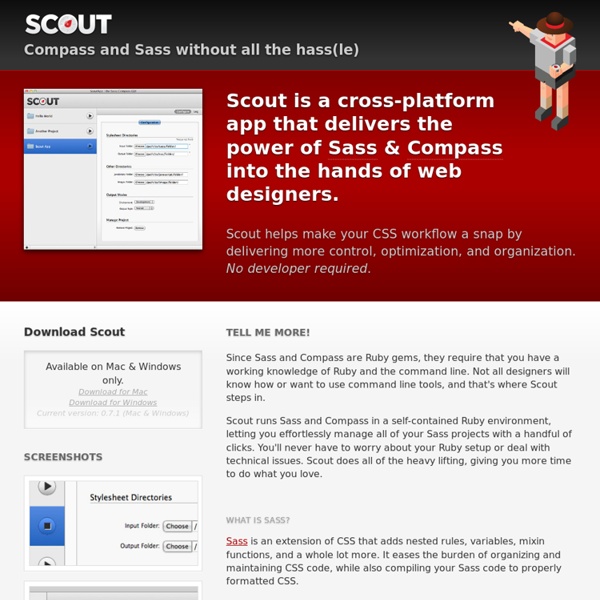Using Source Maps to Debug Sass in Chrome
If you use Sass in your front-end projects, chances are your partials are split in a clean and logical fashion based on a reliable Sass architecture. In such cases, debugging the compiled CSS could be both troublesome and time consuming. Sass provides a flag to enable line numbers (--line-numbers), which includes comments (like below) in your CSS.
SlickMap CSS: A Visual Sitemapping Tool for Web Developers — Astuteo™
Side Projects SlickMap CSS is a simple stylesheet for displaying finished site maps directly from HTML unordered list navigation. It’s suitable for most web sites – accommodating up to three levels of page navigation and additional utility links – and can easily be customized to meet your own individual needs, branding, or style preferences.
HTML KickStart HTML Elements & Documentation - 99Lime.com
Setup Download HTML KickStart Include jQuery and HTML KickStart <script src=" src="js/kickstart.js"></script><!-- KICKSTART --><link rel="stylesheet" href="css/kickstart.css" media="all" /><!
Sass vs. LESS
"Which CSS preprocessor language should I choose?" is a hot topic lately. I've been asked in person several times and an online debate has been popping up every few days it seems. It's nice that the conversation has largely turned from whether or not preprocessing is a good idea to which one language is best. Let's do this thing. Really short answer: Sass
Smart Fixed Navigation
A fixed navigation that allows your users to access the menu at any time while they are experiencing your website. It's smaller than a full-width fixed header, and replaces the back-to-top button with a smarter UX solution. Browser support ie Chrome Firefox Safari Opera 9+ Web pages with a lot of content require a quick way for the user to get back to the top, where the navigation is (most of the time).
Unquoted CSS font family name validator
Wondering if a given character sequence can be used as an unquoted font family name in CSS? Read all about it, or just use this tool. <strong>To use this tool, please <a href= JavaScript</a> and reload the page.</strong> permalink You can use this as an unquoted font family name in CSS:
Getting Started with Sass and Breakpoint Mixin
My colleague Chris was one of those people until recently and is currently finding the delight that comes with scss over css. My one tip for him when he got started was to break up his Sass files into modules by creating _module.scss files, and to use a breakpoint mixin to write the media query changes to the module inline with the rest of the rules. Chris is now much happier with life, so let's take a look at what I'm talking about in more detail. Structuring your Sass When I first started working with Sass I set my project up in the same way that I would usually approach my standard CSS file. NormaliseTypographicalLayoutGeneral@media query overrides
SweetAlert
So... What does it do? Here’s a comparison of a standard error message. The first one uses the built-in alert-function, while the second is using sweetAlert.



